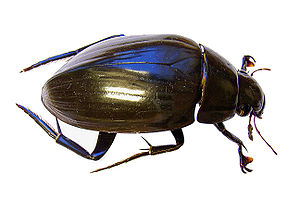Hydrophiloidea
| Hydrophiloidea | ||||||||||||
|---|---|---|---|---|---|---|---|---|---|---|---|---|

Large piston water beetle ( Hydrous piceus ) |
||||||||||||
| Systematics | ||||||||||||
|
||||||||||||
| Scientific name | ||||||||||||
| Hydrophiloidea | ||||||||||||
| Latreille , 1802 |
The Hydrophiloidea are a superfamily of the Polyphaga within the beetles (Coleoptera). They are represented worldwide and comprise four families with around 475 genera and 6600 species.
features
The species of the Histeridae are 1–25 millimeters long, those of the other three families 1–50 millimeters. The subfamily is defined by the following autapomorphies of the imagines: atrophied stigmas on the eighth segment of the abdomen, the lateral sclerites of the ninth tergum are fused dorsally in the male and thus form a narrow bridge in front, the eighth antennae is cup-shaped, the antennae have a three-membered club at the tip and with the exception of a few water beetles, tubular glands are formed on the mandibles .
The autapomorphies the larvae are: their predatory lifestyle, the head whose mouthparts clearly directed forward (prognathous or hyperprognath), the fringed Epistomallappen the head sides, the lack Frontoclypealnaht, the lack of molting seam (Ecdysialnaht) in the third larval stage, which regressed Mola of Mandibles, the labrum that has grown together with the head capsule , the tufts of hair ( penicillus ) on the mandibles ( penicillus ) that are formed with the exception of a few water beetles , the sensory hairs on the outer edge of the penultimate antennae, the non-developed lacinia and galea , the elongated, feeler -like modified maxilla , the inside near the tip a first member of the palpus (palpifer) with angled appendages , the branches of the tentorium arising on the central part of the head capsule, which arise only in the subfamilies Spercheinae and Hydrochinae on the front part, the double-pored spiracles and the strongly membranous abdomen. The pupa has functionless stigmas on the first abdomen segment.
Way of life
The Hydrophiloidea have very different ways of life. You can find species both on land and in water. The adults feed predatory, carrion or vegetable food, the larvae are usually predatory.
Taxonomy and systematics
The Hydrophiloidea are a taxonomically well delimited and well-founded group. Although there are authors who place the beetles in their own superfamily, the histeroidea, this is not justified due to the morphological and biological similarities of the four families. The monophyly of the superfamily is well founded by the numerous autapomorphies of the adults and larvae. A phylogenetic study by Hansen (1997) revealed a sister relationship between the Hydrophiloidea and the Scarabaeoidea ; however, this relationship has not yet been fully clarified. Kristensen & Beutel (2005) follow the view of Lawrence & Newton (1982), according to which the Hydrophiloidea are a sister group of the Staphylinoidea and together form the partial order of the Staphyliniformia .
The superfamily includes the following families:
- Water beetles or piston water beetles (Hydrophilidae) (approx. 2800 species)
- False beetles (Sphaeritidae) (3 species)
- Synteliidae (9 species)
- Stutz beetles (Histeridae) (approx. 3800 species)
supporting documents
Individual evidence
- ↑ a b c d Rolf G. Beutel, Richard AB Leschen: Handbuch der Zoologie - Coleoptera, Beetles, Volume 1: Morphology and Systematics (Archostemata, Adephaga, Myxophaga, Polyphaga partim) . 1st edition. de Gruyter , 2005, ISBN 3-11-017130-9 , p. 157 f . (English).
literature
- Rolf G. Beutel, Richard AB Leschen: Handbuch der Zoologie - Coleoptera, Beetles, Volume 1: Morphology and Systematics (Archostemata, Adephaga, Myxophaga, Polyphaga partim) . 1st edition. de Gruyter , 2005, ISBN 3-11-017130-9 (English).